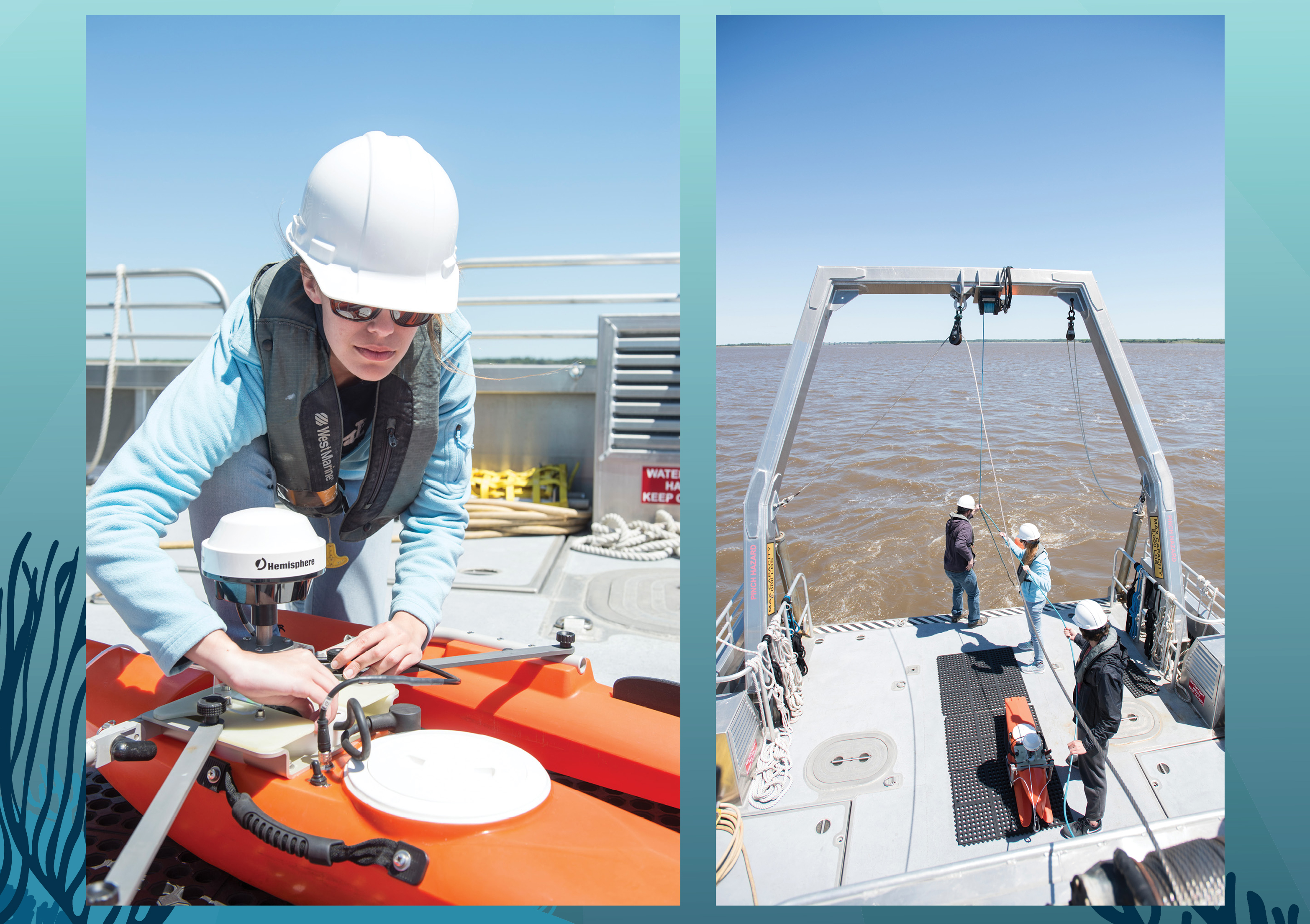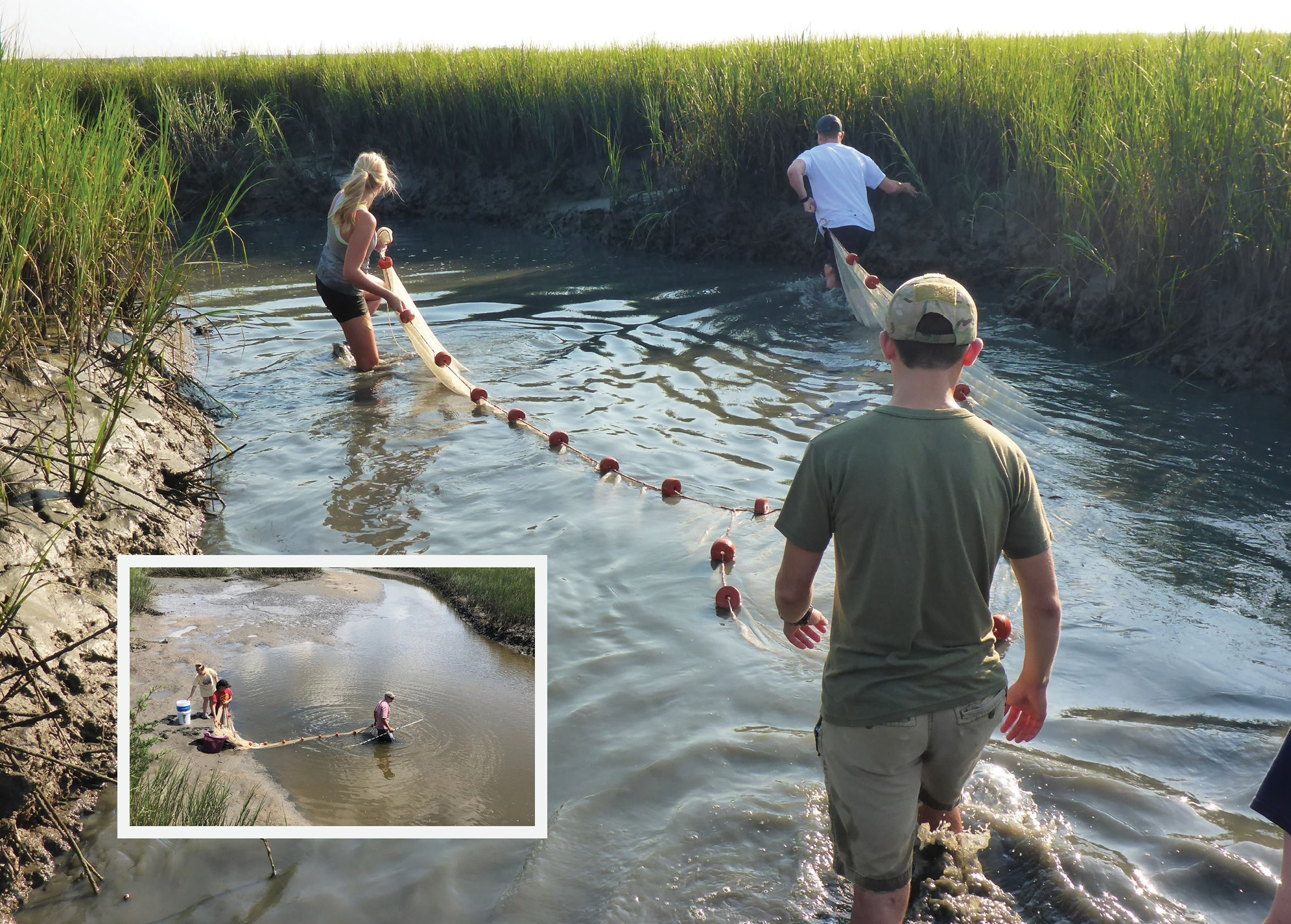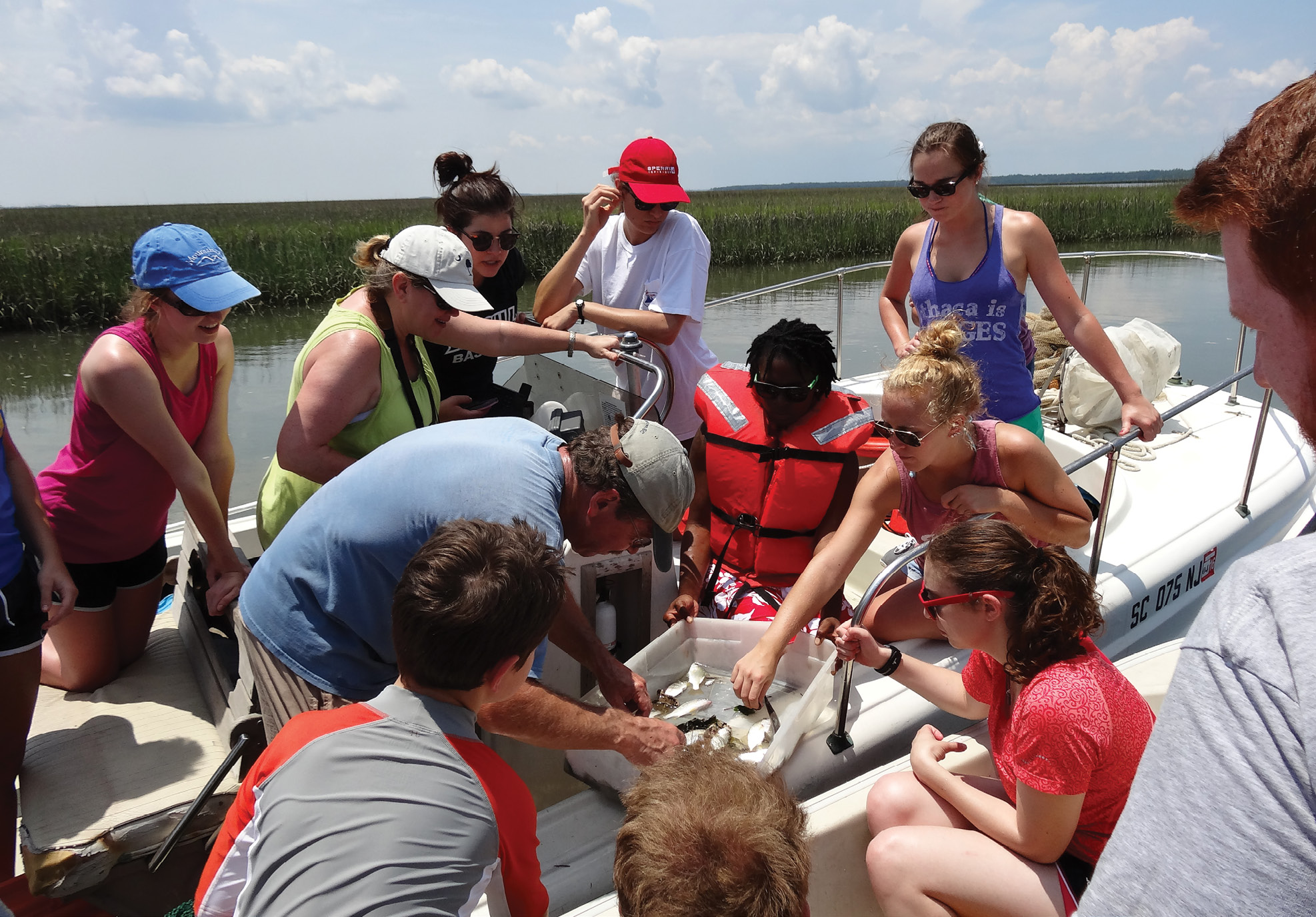CCU and USC immersed in marine science research

Abroadly accepted theory of evolution tells us life as we know it evolved from the sea millions of years ago. Maybe that’s why we are so strongly drawn to our beautiful shore environment and strive to keep it clean and healthy. Two local institutions doing a wealth of work in this area are the Gupta College of Science at Coastal Carolina University (CCU) and the School of Earth, Ocean and Environment (SEOE) at the University of South Carolina (USC). Both have active research and teaching programs along the Grand Strand.
Michael H. Roberts is dean of CCU’s Gupta College of Science, which is named for Sunny Gupta, a 1992 graduate in computer science and 2008 Outstanding Alumnus. Gupta and his wife endowed CCU and the college, which houses the School of Coastal Environment, the Department of Marine Science, the Burroughs & Chapin Center for Marine and Wetland Studies and the university’s nautical facilities and boat operations.
William G. Ambrose Jr., Ph.D., is vice dean of the School of Coastal Environment.
“Our research focuses on the coastal environments and processes where land, ocean, atmosphere and society interact—touching on a wide range of sub-disciplines, basic and applied research, science and policy,” says Ambrose. “Our primary research unit is the Burroughs & Chapin Center for Marine and Wetland Studies. Through its research activities, the center partners with federal and state agencies, local communities and the private sector to infuse the best available science into natural resource management that benefits the public. Our goal is to provide students a top-notch education and make our community a better place to live by leveraging our world-class faculty and facilities in the center and with partnering agencies and universities.”
In addition to the work at the Burroughs & Chapin Center, CCU students and faculty are involved in a wealth of other activities. Those activities include a book on sharks by Dan Abel that is getting international attention; work on oyster reefs and living shorelines by Keith Walters; Till Hanebuth helping Georgetown solve its problem of silt buildup in its harbor; Lauren Stefaniak studying invasive species; Juli Harding studying oyster dynamics; Zhixong Shen studying sediment and containment mobilization from flooding caused by Hurricane Florence; and Varavut Limpasuvan serving as a program officer at the National Science Foundation. Also, the Environmental Quality Lab, which is SC DHEC certified, is doing important work on water quality with many coastal communities.
Ambrose adds, “The School of the Coastal Environment is an important part of CCU’s role as a regional university engaged in education and research benefiting local communities and South Carolina and with a nationally and internationally recognized faculty.”
At USC, the SEOE is equally immersed in similar important work. Its mission is to achieve an understanding of Earth’s diverse environments and human relationships through research, and then convey that understanding through education and community outreach. Professionals and students strive to understand and care for our planet from solid earth, to freshwater and marine systems, to the relationship humans have with those environments. Alicia Wilson, Ph.D., is director of SEOE and Claudia Benitez-Nelson is associate dean.

“I am very excited about our new School of the Earth, Ocean and Environment, which was created to facilitate interdisciplinary and cross disciplinary research and training across the humanities, social sciences and physical sciences,” says Benitez-Nelson. “Forming SEOE was critical for developing transformative solutions to problems that will impact all our South Carolina communities, such as population growth, industrialization and environmental change. The SEOE is committed to being a leader in research by providing the highest quality academic training for our undergraduate and graduate students; developing partnerships with public, private, and nonprofit entities; and conducting outreach to our broader community.”
SEOE has four distinct disciplines for research and education: Geology and Geophysics; the Belle Baruch Institute for Marine and Coastal Sciences; Marine Sciences; and Environment and Sustainability.
The SEOE’s structure provides students an opportunity to pursue a wide range of degree programs. These include a highly ranked marine sciences program, one of the few undergraduate majors in geophysics in the country, and both bachelor of science and bachelor of arts degrees in the environmental arena. Collectively, the SEOE has a significant impact on students, research and development and the well-being of people in South Carolina and beyond. A diverse group of more than 40 faculty members tends to the educational and research needs of students across multiple disciplines.
Paul Gayes, Ph.D., executive director of CCU’s Burroughs & Chapin Center for Marine and Wetland Studies, is working on an artificial reef project, “Smart Reef,” which has received local media attention and is associated with the governor’s Floodwater Commission. The commission was chaired by Tom Mullikin, a research professor at CCU, and several other faculty members were on the commission.
A major field facility for CCU’s marine programs is the Anne Tilghman Boyce Coastal Reserve (ATBCR). This includes a large tract of Waties Island, located on the northeast coast of South Carolina, just above Cherry Grove Beach. Students and faculty regularly use a portion of the Reserve, which is owned by the Coastal Educational Foundation, a private, non-profit support component of CCU.
Classes, laboratories and independent research projects are conducted by undergraduate and graduate students on the property under the guidance of faculty and staff. Additionally, a marine science instructor runs field workshops for precollege classes (K–12) and adults.
Plans and funding are being developed to eventually construct a state-of-the-art marine science building on the island with laboratories, classrooms and offices. The Reserve provides a pristine complex of ocean frontage, fresh and saltwater marshes, tidal creeks and upland woods. Protected from commercial and residential development, it will prove to be increasingly significant for research, monitoring and education about the natural coastal habitat.
When Boyce left the property to the Coastal Educational Foundation, she directed that it be maintained “in essentially a wilderness state.” In 1995, 1,105 acres on Waties Island and the adjoining uplands of the Little River Neck were deeded to the Coastal Educational Foundation. This formed the reserve, which is protected with a perpetual conservation easement through The Nature Conservancy of South Carolina.

At USC, Gwen Geidel, Ph.D., is director of Undergraduate Education for the SEOE and has a background in marine science.
“The B.S. in Marine Science offers a holistic approach to ocean study,” she says. “The interdisciplinary degree lets students draw on various scientific fields in addition to marine systems, including biology, environment, health, physics and social sciences to build an individually tailored curriculum. Even those who are biologically oriented know that one cannot truly understand the organisms that live in the ocean without fully understanding their unique environment.”
Geidel explains that students develop an understanding of the marine environment and the elements that are most fascinating to them, which then informs their career decisions.
“We strive to give students a direct link to graduate school or prepare them to begin careers in Marine Science,” she adds.
Geidel says that about half their students go on to graduate school, while others transition from the classroom to the workforce.
“Our faculty prepare students to identify problems and needs; operate scientific equipment; observe, analyze and synthesize data; analyze cause and effects; form and defend positions; think logically, critically and make analogies; and maintain group cooperation and support effective interaction, all of which are critical to an effective and engaged workforce,” Geidel says.
Alumni of SEOE have developed careers in federal, state and local government agencies; private industry in aquaculture, exploratory geology, satellite imagery and computer ecological modeling; fisheries management; marine technology; the military (particularly the Navy), and the NOAA Corps (where they may serve as commissioned officers onboard NOAA research vessels).
Many students get opportunities beyond the classroom, including traveling with faculty to the Galapagos Islands, or studying sea turtles in Mexico, or evaluating sustainability and marine issues in Puerto Rico or Maine. The school has had four to seven students each year named as NOAA Hollings Scholars who complete an internship with NOAA in Washington, Hawaii, Washington, D.C., and other coastal sites.
Geidel adds, “Some of the most exciting opportunities have resulted from research grants obtained by the school’s internationally respected faculty that have enabled students to conduct research on ocean vessels above the ‘Lost City’ along the Atlantic Mid-Ocean Ridge, in the Pacific and Caribbean, and miles deep in the sea via the ALVIN submersible.”
CCU also offers qualified students opportunities to participate in study abroad programs, where they travel to exotic destinations for classroom and field work learning. One popular program, called “Maymester,” gives students a two- to five-week experience. Programs include: Oceanography in Scotland; Shark Biology in the Bahamas; Sea Turtle Biology in Costa Rica; and Ecology of Coral Reefs in Jamaica. Faculty and experienced advisors assist students in meeting the academic, financial and logistical considerations that go into the selection process.
USC’s Belle Baruch Institute for Marine and Coastal Sciences was started in 1969 with an endowment from Baruch. Hobcaw Barony, a 16,000-acre preserve on the ocean just north of Georgetown, is home to an extensive research and teaching facility that includes laboratories, classrooms, conference space, offices and field research stations.

Jay Pinckney, Ph.D., is director and professor at the institute and is a leading scientist who does important research in addition to managing the institute.
When asked about the research being conducted at the SEOE, Benitez-Nelson says, “Our coastlines are an invaluable economic resource. I am particularly excited about an ongoing National Science Foundation Award for almost $1 million that was awarded to Professor Pinckney and our colleagues that explores how groundwater, rich in the essential nutrient nitrogen, supports biodiversity and biological production along our coastlines.”
“The Baruch Institute for Marine and Coastal Sciences conducts research on coastal systems, global change and food webs,” says Pinckney. “The North Inlet Estuary—our primary research site—is an environmentally unique location that offers incredible research opportunities. One of the major research contributions of the Baruch Institute is support of the North Inlet-Winyah Bay National Estuarine Research Reserve (NI-WB NERR). This program, sponsored by USC and the NOAA, provides continuous monitoring of a variety of water quality and meteorological conditions to measure long-term changes in North Inlet and Winyah Bay. These data are critical for addressing questions about ecosystem responses to global warming and sea level rise.”
Pinckney adds, “The real-time data are freely available to the public at cdmo.baruch.sc.edu and are frequently accessed by locals to determine tides, fishing conditions and weather.”
More information on this program is available at northinlet.sc.edu.
To learn more about these exciting programs or to explore higher education opportunities at these Institutions, contact:
Coastal Carolina University School of Coastal Environment
coastal.edu/sce
(843) 234-3411
University of South Carolina School of Earth, Ocean and Environment
sc.edu/study/colleges_schools/artsandsciences/earth_ocean_and_environment/index.php
(803) 777-0169
NOTE: Photos of faculty and students not wearing masks were taken prior to the COVID pandemic.